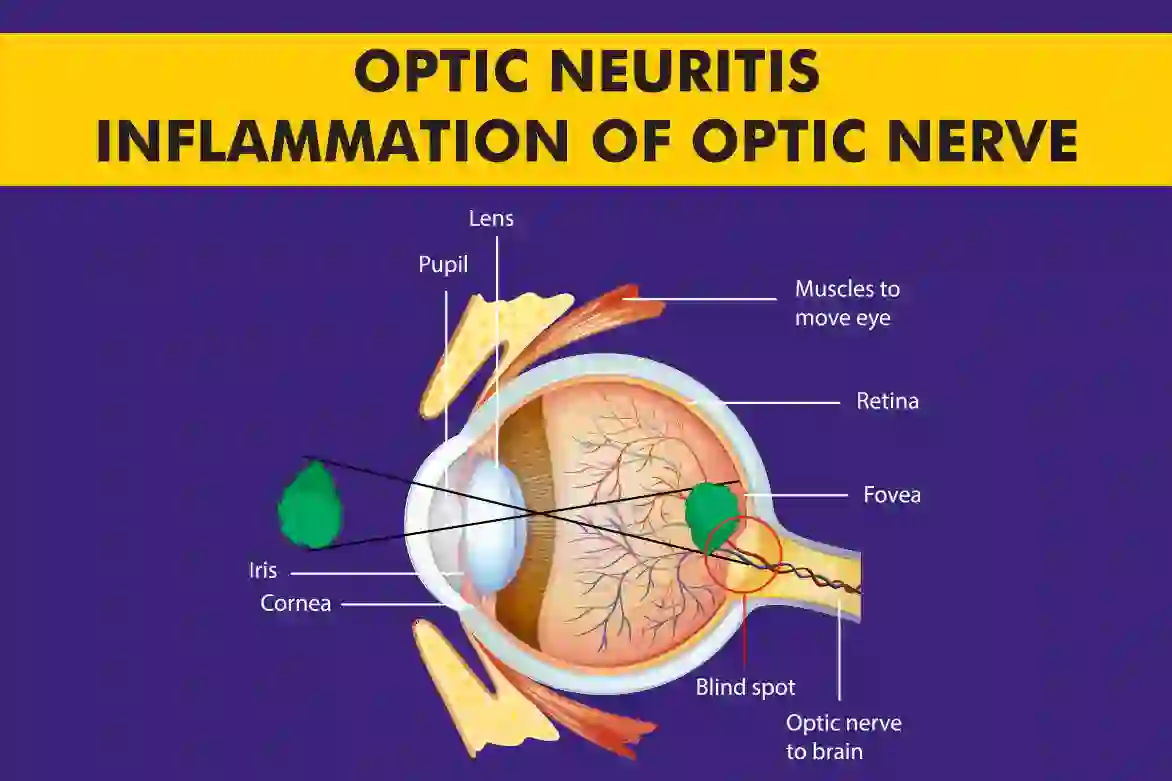Optic neuritis is a condition characterized by inflammation of the optic nerve. The optic nerve is responsible for transmitting visual information from the eyes to the brain. When it becomes inflamed, it can lead to various symptoms and visual disturbances. This inflammation can disrupt the transmission of signals and result in vision problems. Optic neuritis can affect people of all ages, although it is more commonly seen in young adults, especially women.
In the following sections, we will explore the different aspects of optic neuritis, including its symptoms, causes, diagnosis, treatment options, prevention strategies, prognosis, and risk factors.
What Is Optic Neuritis (Optic Nerve Neuritis)?
Optic neuritis is a condition that primarily affects the optic nerve, which is responsible for transmitting visual information from the eyes to the brain. When the optic nerve becomes inflamed, it can cause a range of symptoms and visual disturbances. Optic nerve neuritis can occur as an isolated episode or be associated with certain medical conditions, such as multiple sclerosis. It can affect people of all ages, but it is more commonly seen in young adults, particularly women.
Types of Optic Neuritis
Optic neuritis can be classified into different types based on various factors. The three main types of optic nerve neuritis are typical, atypical, and pediatric optic neuritis. Depending on location, it can be classified as Neuroretinitis, Retrobulbar, and Papillitis.
Typical optic neuritis refers to the inflammation of the optic nerve that occurs in isolation, without any underlying medical conditions. It is often associated with demyelination, where the protective covering of the nerve, called the myelin sheath, is damaged.
Atypical optic neuritis refers to cases that do not fit the typical pattern and may be associated with other medical conditions or have unique characteristics. These cases may require further investigation and specialized treatment approaches.
Pediatric optic neuritis occurs in children and adolescents. It can present differently than in adults and may require different management strategies. It is important to recognize and address optic nerve neuritis in pediatric patients promptly.
Understanding the different types of optic or eye neuritis can help in determining the appropriate diagnostic and treatment approaches for each individual case.
What Are Optic Neuritis Causes?
The optic neuritis causes are not always known, but it is believed to be an autoimmune condition. In autoimmune diseases, the body’s immune system mistakenly attacks its own tissues, in this case, the myelin sheath that covers the optic nerve.
Certain factors may contribute to the development of optic neuritis, including viral infections, bacterial infections, exposure to toxins, and genetic predisposition. Additionally, eye neuritis is often associated with multiple sclerosis, a chronic autoimmune disease that affects the central nervous system leading to cross reactivity.
Identifying the underlying causes of optic neuritis can help in managing the condition effectively and preventing future episodes.
What Are Optic Neuritis Symptoms?
Optic neuritis can cause various symptoms and visual disturbances. The most common optic neuritis symptom is a sudden loss of vision in one eye, which may occur over hours or days. This vision loss is often accompanied by pain or discomfort, particularly with eye movement.
Other optic neuritis symptoms can include blurred or dim vision, color vision problems, a decrease in visual acuity, and a reduced ability to perceive contrast. Some individuals may also experience eye pain, especially when moving the affected eye.
It’s important to be aware of these optic neuritis symptoms and seek medical attention if they occur, as early diagnosis and treatment can help prevent further vision loss and manage the condition effectively.
Optic Neuritis Diagnosis & Test
Diagnosing optic/eye neuritis typically involves a comprehensive eye examination and a review of the patient’s medical history and symptoms. The eye examination may include visual acuity tests, color vision tests, and a thorough examination of the optic nerve.
Additional tests may be conducted to confirm the diagnosis and rule out other potential causes of the symptoms. These tests can include magnetic resonance imaging (MRI) scans, blood tests, and lumbar puncture to analyze the cerebrospinal fluid.
Prompt and accurate diagnosis is crucial in order to start appropriate treatment and prevent complications.
Optic Neuritis Treatment
The treatment of ophthalmic neuritis aims to reduce inflammation, manage symptoms, and promote recovery. Optic Neuritis treatment options can vary depending on the severity of the condition and the individual patient’s needs.
In some cases, ophthalmic neuritis may resolve on its own without specific treatment. However, in other cases, medications such as corticosteroids may be prescribed to reduce inflammation and speed up recovery.
Other supportive measures, such as pain management, vision aids, and rehabilitation therapies, may also be recommended to improve the patient’s quality of life and visual function.
You can find about the types of low vision aids here.
It is important to consult with a healthcare professional to determine the most appropriate Optic Neuritis treatment approach for each individual case.
Optic Neuritis Prevention
While there is no guaranteed way to prevent ophthalmic neuritis, certain strategies may help reduce the risk of developing the condition or experiencing recurrent episodes.
Maintaining a healthy lifestyle, including regular exercise, a balanced diet, and adequate rest, can support overall immune system health and reduce the risk of autoimmune conditions.
Check out 10 Simple Eye exercises For Eye relaxation here.
Avoiding exposure to potential triggers, such as infections or toxins, may also help prevent optic neuritis. Additionally, managing underlying medical conditions, such as multiple sclerosis, can contribute to reducing the risk of ophthalmic neuritis.
It is important to discuss preventive measures with a healthcare professional, especially if there is a known risk or history of eye neuritis.
Optic Neuritis Prognosis
The prognosis for eye neuritis varies depending on several factors, including the underlying cause, the severity of the condition, and the individual patient’s response to treatment.
In many cases, optic neuritis resolves on its own within a few weeks to months, and vision gradually improves. However, some individuals may experience persistent visual deficits or recurrent episodes of optic nerve neuritis. Regular follow-up with healthcare professionals and adherence to optic neuritis treatment plans can help monitor the condition and manage any potential complications.
It is important to discuss the prognosis and long-term outlook of optic neuritis with a healthcare professional, as each case can be unique.
What Are the Risk Factors of Optic Neuritis?
This condition can occur in individuals of all ages, but certain optic neuritis risk factors may increase the likelihood of developing the condition.
Women are more commonly affected by optic nerve neuritis than men, and the condition is most frequently seen in young adults. Additionally, individuals with a family history of optic neuritis or other autoimmune conditions may have a higher risk of developing the condition. Optic neuritis is often associated with multiple sclerosis, and individuals with a diagnosis of multiple sclerosis have an increased risk of developing optic neuritis.
Conclusion
In conclusion, identifying optic neuritis causes and symptoms require prompt medical attention to prevent potential vision loss and manage underlying conditions effectively. Understanding optic neuritis symptoms, diagnosis methods, and treatment options empowers individuals to seek timely intervention, ensuring the preservation of optic nerve function and overall eye health. Through awareness, education, and medical advancements, we can continue to improve the prognosis and quality of life for those affected by this inflammatory condition.
FAQs
Can optic neuritis be cured?
Optic neuritis can often be managed and treated, but whether it can be fully cured depends on the underlying cause.
Can you live a normal life with optic neuritis?
With proper management and treatment, many people with optic neuritis can lead normal lives, although some may experience lingering visual symptoms.
Can optic neuritis cause blindness?
Optic neuritis can lead to temporary or permanent vision loss in some cases, but it doesn’t always result in blindness. Prompt treatment can help minimize the risk of severe vision impairment.
You can also read about Corneal Blindness here
What are the symptoms of optic neuritis?
Common symptoms include vision loss, blurred or dimmed vision, eye pain (especially with eye movement), color vision disturbances, and sometimes flashing lights.
Can the optic nerve repair itself?
The optic nerve can partially repair itself in some cases, but the extent of recovery varies among individuals. Treatment and rehabilitation efforts can support nerve healing and functional improvement.
Can optic neuritis cause death?
Optic neuritis itself is typically not life-threatening, but complications arising from severe cases or underlying conditions could potentially lead to serious health risks.





